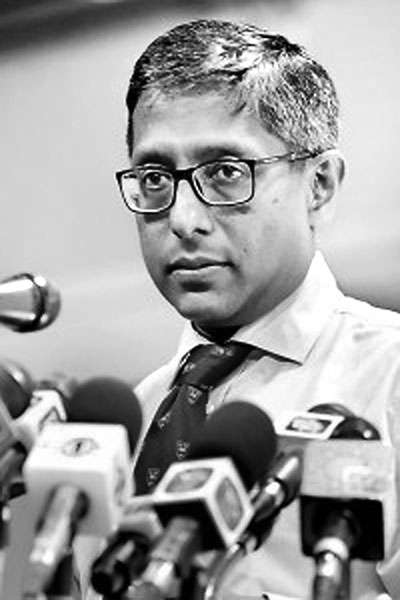03 Sep 2018 - {{hitsCtrl.values.hits}}
Falling sick could be one of the most expensive things that could ever happen to your life. With the soaring prices of medicines, channelling fees and hospital charges, people try their best to avoid falling sick. But your immune system may not be that strong in certain instances. In terms of the prices of medicines Sri Lanka has been struggling to regulate the prices of essential medicines and  streamline the importation of various drugs for the past few years. As the pharmaceutical industry went in search of more profits, its sole purpose of curing patients from ailments and illnesses took a back seat. Hence the National Medicines Regulatory Authority (NMRA) was established in 2015 by an Act of Parliament. The difference between the Cosmetic Drugs and Devices Regulatory Authority and NMRA is that the NMRA is mandated by law to look at four areas including the safety, efficacy of medicines, the need and the cost. With the reduction of prices of 48 essential medicines, the authorities took a step in the proper direction. But to what extent it has impacted patients’ lives remains a question.
streamline the importation of various drugs for the past few years. As the pharmaceutical industry went in search of more profits, its sole purpose of curing patients from ailments and illnesses took a back seat. Hence the National Medicines Regulatory Authority (NMRA) was established in 2015 by an Act of Parliament. The difference between the Cosmetic Drugs and Devices Regulatory Authority and NMRA is that the NMRA is mandated by law to look at four areas including the safety, efficacy of medicines, the need and the cost. With the reduction of prices of 48 essential medicines, the authorities took a step in the proper direction. But to what extent it has impacted patients’ lives remains a question.
With that in mind, the Daily Mirror spoke to Prof. Asita de Silva, Chairman of the NMRA who expressed his views about the impact of the reduction of prices, how it will be continued for 25 more essential drugs, challenges with bringing prices down and benefits to patients.
 medicines?
medicines?Practically every regulatory authority including those in Organization for Economic Cooperation and Development (OECD) countries regulate the prices of medicines in different ways. In the UK they regulate through a number of mechanisms. They do what’s called profit capping and will show a particular profit margin after studying balance sheets. The second is that they incentivize pharmacies for using generic substitutions. My main objective is to increase the availability or accessibility to quality assured medicine. Price is a key determinant of access to medicine. In Sri Lanka, 50% of people purchase medicine out of their pocket. So whom we have targeted are people spending out of their pocket and we have regulated prices of 48 essential medicines. So the principal is essential and very commonly used medicines. These 48 medicines covered over 450 brands and the prices were regulated through a maximum retail price. By doing that we said that if there are brands with prices above the MRP their prices had to come down and all brands with prices below that cannot change. We follow some international guidelines given by the World Health Organization (WHO) when it comes to price regulation. During the 2015-2016 period, WHO experts were sanctioned to work here and study the drug market and she wrote a report titled ‘Pharmaceutical price control in Sri Lanka’. She goes on to say how corrupt the supply chain is. She also underlines the need for a major price control exercise based on retail prices. She identifies things that we knew and the argument is why we can’t have a mark-up based on the Cost Insurance Freight (CIF).
Take paracetamol for example, panadol is the most widely used brand. So from Rs.3 we brought the price down to Rs.1.30. As a result, there was a 91% increase in their market share. People believe panadol is better than other drugs because it is more affordable
According to the report, pharmaceuticals importers almost inflate the CIF. This means that we have a massively loaded CIF and the request was to give an 85% mark-up on top of that. The CIF model doesn’t work in countries where this value isn’t verifiable. This happens in Saudi Arabia and to do that Saudi Arabia follows the CIF plus percentage approach. But in doing that the regulator requires exhausting information. In summary they ask the factory price of the country of origin certified by that country’s regulator. They also look at the wholesale price in the country of origin. They also require the proposed CIF to the country plus the price of the product in all the countries that it is sold and these should be certified by the Saudi Embassies in those countries. It is after this process is complete that they take the CIF as real. As a result the CIF model is completely discouraged and it goes on to say that there’s unethical and inappropriate drug promotion within the pharmaceutical industry which is widespread. Inappropriate drug promotion takes place in the form of rebates and discounts in the distribution chain like bonuses and sample perks. This is over and above the mark-up you’re allowed to keep as a retailer. So you’re leveraging the whole system by doing that. Therefore if you go back to the argument of an open market economy, the patients’ choice is not free. The patient is hugely leveraged by an overloaded CIF and a brand that is prescribed by the pharmacist who prescribes the brand that gives him the best deal.
We did that with 48 medicines and follow the Indian model. Our opinion based on this report is that current pricing needs to be regulated. Then we had the question of how best our approaches were. In OECD developed countries pharmaceutical cost of medicine is only 18% of their budget. In low and middle income countries this can go up to 60%. In Sri Lanka it is between 30-40% of the health budget. This shows that we spend more. We analyzed the impact of these 48 medicine prices from the last quarter of 2016 to the last quarter of 2017. Out of these 271 brands have impacted and others remain the same. In the near future we are going to price regulate 25 more medicines out of which 15 are normal medicines and 10 are cancer drugs.
There is a reason why cancer drugs were not regulated before. For cancer drugs the retail market is only relevant for only 5% of the population because a large majority seek treatment in the state institutions. Therefore capping retail prices in cancer drugs benefit only 5-10% of the population. We need to save money for the patients. Over this one year period the savings to people was Rs. 4.5 billion by spending less on the medicine we take. Since very few people seek cancer therapy in the private sector we didn’t want to regulate retail prices since they did not impact very much. Therefore we are regulating tender prices which the government purchases. So with this new proposal the saving is to the treasury and by saving money to the treasury we believe that more patients can be given these cancer products. The cost in state institutions for cancer care medicine is about Rs. 7.1 billion rupees every year. 60% of that is spent on tenders. So our advice to the minister was to regulate the prices of tenders of these 10 products. We estimate an annual Rs. 1.7 billion saving to the government when we implement this.
Take paracetamol for example, panadol is the most widely used brand. So from Rs.3 we brought the price down to Rs.1.30. As a result, there was a 91% increase in their market share. People believe panadol is better than other drugs because it is more affordable. This could be done only if there’s competition and we encourage this competition by registering more quality-assured medicine and because the pricing is not appropriately done we have to intervene per the WHO guidelines. This is the same with stents. The National Cardiology Institute believes that for a year the number of deaths due to increased number of stenting has come down by about 3-4%. By creating a competition for the price and by lowering the tender price from Rs. 100,000 to Rs. 50,000 all people interested in going for that tender would have to compete below Rs. 50,000.
Of course. The NMRA now follows strict conditions. We do a significant capping regarding the number of brands. But you may have heard that there are 100-150 brands of one drug and if you go to the market you won’t be able to find the prices of more than 10 of these brands. This is completely unaccepted and unethical. Here what happens is they registered two or three brands of the same medicine and they don’t bring a single tablet into the country. They hold it for tenders or they block competition because once they register the product nobody else could take it. The problem with medicine is that importation is only allowed through one local agency. In the new legislation it very clearly states that if you haven’t supplied the medicine for two years after getting registered, the registration will be removed. Through this mechanism we have identified so many and we would be implementing it.
Quality assurance comes by stringent evaluation internally which our regulatory pharmacists do. The second would be looking at data in other countries, post-marketing surveillance and so on. Most importantly a rigorous assessment should be made here. The third component would be quality assurance in terms of laboratories. We do that but it’s not good enough because the National Quality Assurance Laboratory lacks capacity. That will be our next phase where we will setup a state-of-the-art laboratory and then we will test every batch of medicine that comes into the country. Therefore we currently depend on the information that we get from outside and the stringent evaluation we do. By price regulation we are taking out a lot of drugs we believe are not quality assured. As a result, people now have access to better drugs.
10 Jan 2025 1 hours ago
10 Jan 2025 2 hours ago
10 Jan 2025 4 hours ago
10 Jan 2025 4 hours ago
10 Jan 2025 4 hours ago